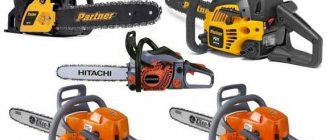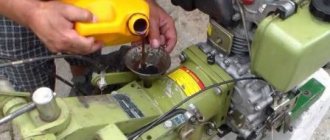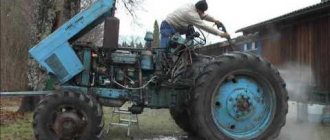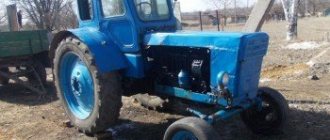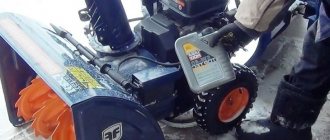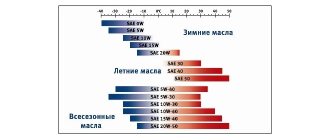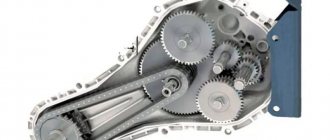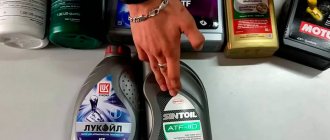Hydraulics MTZ-82 Belarus is an important component in the design of a universal row-crop wheeled tractor with a traction class of 1.4 t, designed to perform a wide variety of agricultural work with mounted, semi-trailered and hydraulically trailered equipment. The hydraulic system allows you to perform labor-intensive work in conjunction with bulldozers, excavators, loaders, hole diggers, and is also used to drive stationary agricultural machines.
The following brands of motor oil are poured into the power steering (power steering) housing of the MTZ-80.82 tractor: in summer M10G2 or M10B2, in winter M8G2 or M8B2 (GOST 8581-78).
Hydraulic oil. What kind of oil should I put in hydraulics?
Hydraulics MTZ-82 Belarus is an important component in the design of a universal row-crop wheeled tractor with a traction class of 1.4 t, designed to perform a wide variety of agricultural work with mounted, semi-trailered and hydraulically trailered equipment. The hydraulic system allows you to perform labor-intensive work in conjunction with bulldozers, excavators, loaders, hole diggers, and is also used to drive stationary agricultural machines.
The following brands of motor oil are poured into the power steering (power steering) housing of the MTZ-80.82 tractor: in summer M10G2 or M10B2, in winter M8G2 or M8B2 (GOST 8581-78).
transmission and hydraulic oil
Questions can only be asked after registration. Please login or register.
Hello! Share your experience, what kind of oils do you use? I purchased an MTZ-82p, I need to change the transmission and hydraulics. Now there is a large choice on the market, different prices, there are many manufacturers, I’m just lost.
I'm also very interested
Maybe there is a separate topic? Post a link please!
Well, what can I say, right now they all pour Lukoil avant-garde into the engine, into the transmission tad 17, tep-15, I pour diesel into the hydraulics, some spindles, but then it leaks everywhere. Again, it depends on the pocket, you can fill it with hado, even the transmission, even hydraulic, the oil is excellent, I pour hado into a passenger car, for 50 thousand mileage for 1600 rubles, and everything is fine, But with hydraulics, especially an excavator, pouring expensive oil is cruel, in the sense that the hoses often break. (I’m silent about hose manufacturers )
Comrades, tell me. The instructions (and the book) require pouring motor oil into the hydraulic system of the MTZ-80 tractor. It is motor driven, not hydraulic. Question: why isn’t it hydraulic?
IFA-M25(85), T-25A & T-40M(91), MTZ-80(93), 1PTS-2.5(92), L-201&L-651(93), etc.
Comrades, tell me. The instructions (and the book) require pouring motor oil into the hydraulic system of the MTZ-80 tractor. It is motor driven, not hydraulic. Question: why isn’t it hydraulic?
Hello colleague. Because using hydraulic oil it is impossible to achieve the tractor hydraulic linkage parameters stated by the manufacturer (for example, the weight of the implement being lifted, the lifting speed, etc.
Comrades, tell me. The instructions (and the book) require pouring motor oil into the hydraulic system of the MTZ-80 tractor. It is motor driven, not hydraulic. Question: why isn’t it hydraulic?
if the elements of the hydraulic system installed on the tractor were operable on hydraulic oil, then there would be no recommendation to fill in engine oil. And so on Senka and the cap. The pumps are crap that cannot work normally with hydraulic oil, the same applies to the distributors used. and the pumps and distributors from imported hydraulic manufacturers are several times more expensive - no one will put them on the assembly line - this increases the cost of the final product. And in the light of recent years, the equipment does not shine with quality, and if the price for it is also inflated by installing some components, then it the buyer will generally lose price interest. And so many are already looking towards foreign cars.
Thank you.
IFA-M25(85), T-25A & T-40M(91), MTZ-80(93), 1PTS-2.5(92), L-201&L-651(93), etc.
Guys, tell me! On the new tractor, when cold, all the gears turn on with a bang, it’s even pleasant to drive, but when it warms up, they turn on terribly, everything crunches, growls, especially the 9th, I try everything with double squeezing and over-throttle, but little helps. Here's a question, on old MTZ there is a brake, on new ones there is no, I think while the oil is cold it is thick and the shaft stops, and when it heats up it liquefies, TEP-15 oil from the factory, 160 m/h, I haven’t changed it yet, so I think maybe more Will quality oil help solve the problem? Before it was a T-40, it flew like a car, you just had time to get the gears in, nothing crunched, nothing growled! Or replace it with a new TEP-15? Which is better TEP-15 or TAD-17?
The instructions (and the book) require pouring motor oil into the hydraulic system of the MTZ-80 tractor.
Design and principle of operation of MTZ-82 hydraulics
The MTZ-82 machine is equipped with a hydraulic system with a separate-aggregate type control, divided into a mounted hydraulic system and a power steering system (power steering). The assembly units operate from the same hydraulic drive and perform different functions.
The hydraulic attachment system is responsible for the operation of the auxiliary MTZ-82 attached to the mechanism. The tractor steering system ensures a reduction in the forces on the steering wheel applied by the driver when turning.
The hydraulic device includes:
- gear pump;
- distributor;
- main Ts-100 and 2 remote Ts-75 cylinders;
- power position regulator;
- hydraulic adhesion weight increaser (GSV);
- hydraulic accumulator;
- locking devices;
- breakaway couplings;
- hydraulic unit housing with filter;
- connecting fittings.
All hydraulic components are assembled and connected at the Minsk Tractor Plant; a diagram is used to connect the valve-spool separate hydraulic system.
The pump is connected by a suction pipe to the tank, and by oil discharge pipes to the distributor and power regulators. The distributor directs oil through the drain tube into the tank or through an intermediate pipe into the hot water pump, from the hot water pipe into the power regulator, through the high pressure hose into the power cylinder or through the side outlets to the machine drive. The left side and rear terminals are duplicated.
There are metal pipelines on the regulator and accumulator, attached using brackets and rubber gaskets to the gearbox cover. The rear output piping is connected to the cab brackets. The power regulator is controlled by a handle located to the right of the operator’s workplace.
To drive the hydraulic system, a pump NSh-32-2 with rotation to the right is used.
It turns on at low speeds of the tractor engine and is driven from the intermediate gear driving the rear power take-off shaft.
Selection of oils for the type of hydraulic system
Users of tractors and walk-behind tractors often ask the question of which oil is best for a particular type of engine. We found out whether there are selection criteria and how to navigate among them.
Different types of oils differ from each other by marking W + number. This marking carries the meaning: the temperature at which the liquid does not freeze. The selection of oil for a tractor engine is based on the main characteristics: engine type, hydraulic type and ambient temperature. Universal types of oils are suitable for mini tractors.
Review of the most popular brands of oils
Let's start with the fact that the function of oil is to form a durable thin film on the surfaces of rubbing parts. In addition, oil removes products of fuel combustion and wear of parts from the engine friction zone. All this turns into a suspension contained in used oil. We think we can all imagine what it looks like.
In hydraulics, fluid has only one function - when compressed, it transmits force from the lever (mechanical action on the hydraulic system) to attachments, such as a front loader. Sometimes this fluid is taken from the engine lubrication system. But separate oil containers are good because oil from different systems does not mix.
Winter oils are designated by the letter W (from the word winter). SAE divides motor oils into 10 classes, differing in viscosity-temperature characteristics. Typical brand designations for winter oils are OW, 5W, 10W, 15W, 20W and 25W, for summer oils - 20, 30, 40 and 50.
What is the meaning of these numbers? The lower the number, the lower the temperature at which the oil remains operational - it continues to efficiently lubricate the rubbing surfaces, flowing freely to them. The higher the number in the summer oil class, the higher the oil remains viscous at higher temperatures, maintaining a stable oil film between the rubbing parts
In addition, there is also multi-season oil. Its viscosity grade is indicated by a hyphen (-), for example 10W-40; Moreover, the greater the difference between the first and second numbers in the designation, the greater the temperature range this oil can operate in.
There is also an API (American Petroleum Institute) classification accepted in many countries, which relates the performance properties of oils to engine operating conditions. The conditions for using oils are indicated by two letters:
- the first determines the engine type (S - gasoline, C - diesel)
- second (A, B, C, D, E, F, G, H) - level of performance properties of motor oil
Moreover, the conditions for using the oil become more stringent according to the increasing serial number of the letter in the alphabet. Oils of classes SA and CA are intended for unboosted diesel engines designed before the 70s, operating under light loads. And oils of SH and CD classes are for highly accelerated multi-valve engines and supercharged engines operating in harsh operating conditions under high loads (models produced since 1989).
Packages are usually marked with oil classification symbols according to both systems. For simplified classification, motor oils can be divided into three large groups that characterize the composition of the oil.
- mineral (obtained from petroleum products)
- synthetic
- semi-synthetic (representing a mixture of the first two)
This division is quite justified, since mineral and synthetic oils differ in viscosity-temperature characteristics, and therefore in the area of application and, which is also important, in cost. It should be noted that all kinds of additives play an important role, affecting primarily the properties of the oil, as well as its price.
Nowadays, multi-season oils are most often produced, which are used equally actively in gasoline and diesel engines; they can also be poured into tractors.
For passenger cars, it is better to avoid multigrade oil. All-season oils can be safely poured into tractor diesel engines, which are more wear-resistant and high-torque. The main thing is that the temperature at which the minitractor operates matches the capabilities of the oil.
Possible malfunctions and ways to eliminate them
During operation of the MTZ-82 tractor, malfunctions and defects may be identified in the hydraulic system of the machine: levers and hoses are worn out, adjustments are poorly adjusted, problems with insufficient traction, and agricultural implements do not work.
Let's look at the main malfunctions, causes and methods for eliminating them:
- Attachments are not raised or lowered using hydraulics. The reason is insufficient fluid level in the tank. Therefore, it must be topped up if necessary. Install the handle on the lock if the hydraulic adjustment of the power cylinder piston is disturbed.
- Increased oil heating occurs as a result of incorrect adjustment of the regulator control sector. Adjust the position of the sector. If the regulator control handle is not locked, set it to the “Regulator off” position.
- Slow lifting of the hitch with agricultural implements is associated with increased oil leakage in the pump. The pump needs to be replaced.
- When the GSV is turned on, the wheels slip. Adjust the length of the lever that controls the main cylinder, because the traction force adjustment is broken.
- The attachment rises slowly. Right rotation pumps do not work - the pump is restored to good condition or replaced with a new one.
- The weapon is not kept in transport condition. There is a leak of working fluid. It is necessary to replace the O-rings, distributor or GSV.
- The optimal plowing depth is not ensured. Replace or sharpen plow shares.
Composition and chemical properties
To produce gear oil, extracts of petroleum (remaining after selective cleaning) and distillate oils are mixed with anti-wear and extreme pressure additives containing phosphorus, chlorine, sulfur and molybdenum disulfide.
Until the time when cars appeared, which were characterized by highly loaded transmissions, nigrol (TEP-15) was used to lubricate the above units.
The viscosity of TM ranges from 6-20 mm²/s at a temperature of 100 °C. For open gears, it is advisable to use oils with high viscosity additives (from 50 to 500 mm²/s at 100 °C).
For drive axles and hypoid transmissions, hypoid oils must be used. They contain additives that begin to interact with the material and create compounds that form extreme pressure coatings. The use of oils not intended for hypoid gears is strictly prohibited. The reason for this is the high probability of failure of the unit.
The key functions of transmission oil are to lubricate the internal components of the transmission and provide heat dissipation.
The use of high-viscosity TM in transmission mechanisms can lead to the fact that during rapid rotation of gears, lubricant will not have time to get between the rubbing parts. Thus, strong resistance to internal friction forces will lead to a decrease in transmission efficiency.
When changing the oil in MTZ tractors, you need to ensure that dust, dirt and other foreign bodies do not get in. When filling with liquid oil, they most often use a mug with a spout, a blower, a mechanized oil filler and a piston syringe.
If there is not enough oil in the tractor, further operation should be stopped until the situation is corrected.
The lubricant should be stored in a clean container that is tightly closed with a lid. It must be signed, indicating the name and variety. Do not leave the container open, as this may cause contamination with mechanical impurities or water ingress.
Lubrication table
| Position number on the maintenance diagram | Name of lubrication points | Name, brand and designation of the standard for lubricants and liquids | Number of lubrication points | Lubrication frequency, months | ||||
| Lubrication during operation at temperatures | Refueling during operation, l | Lubrication during storage (up to 6 months) | basic | substitutes | ||||
| from -40°С to +5°С | from +5°С to +50°С | |||||||
| 21 | Diesel crankcase | Motor oil: Basic | ||||||
| M-8DM GOST 8581-78 | M-10DM GOST 8581-78 | 12,0 | 12,0 | 1 | 500 | |||
| Duplicate | ||||||||
| M-8G2K GOST 8581-78 | M-10G2K GOST 8581-78, | 250 | ||||||
| M-10G2 modernized TU 38.401-58-169-96 | 500 | |||||||
| 27 | Fuel pump | Motor oil, the same as in a diesel crankcase | 0,25* | -//- | 1 | When installing a new or repaired pump | ||
| 37 | Air cleaner tray | Pre-settled and filtered used motor oil | 1,5 | 1.5 | 1 | 500 | ||
| 22 | Power transmission housing | Basics | 1 | During seasonal maintenance | ||||
| Transmission oil TAp-15V; TSp-10; TSp-15K GOST23652-79 | 40 | 40 | ||||||
| Duplicate | ||||||||
| Transmission oil TAD-17 and GOST 23652-79 | ||||||||
| 11 | Wheel gear housing (Belarus 82R) | Same | Same | 3,7 | 3,7 | 2 | Same | Same |
| 24 | FDA wheel reducer housing | -//- | -//- | 1,8 (2,0)** | 1,8 (2,0)** | 2 | -//- | -//- |
| 24 | FDA housing | Same | Same | 1,6 (3,7)** | 1,6 (3,7)** | 1 | -//- | -//- |
| 24 | Housing of the upper conical pair of FDA (82.1) | -//- | -//- | 0,25 | 0,25 | 2 | -//- | |
| 24 | Intermediate support for FDA drive | -//- | -//- | 0,15 | 0,15 | 1 | -//- | |
| Drive pulley | -II- | -II- | 0,50 | 0,50 | 1 | -//- | ||
| 26 | Hydraulic unit housing and power steering unit | Basics | ||||||
| Motor oil M-10G2 modernized TU 38.401-58-169-96 | ||||||||
| M-8G2K GOST 8581-78 | M-10G2K GOST 8581-78 | |||||||
| Duplicate | ||||||||
| Industrial oil “Hessol Nudraulikoil”; "Bechem Staroel No. 32", HLP 32, I-3A GOST 20799-88 | 21.5 (UK) 17.5 (m/g cable) | 21.5 (UK) 17.5 (m/g cable) | 1 | -//- | ||||
| 23 | Power steering building | Same | Same | 6,0 | 6,0 | 1 | -//- | |
| 31 | Clutch release bearing | Main lubricant: “Litol-24” GOST 21150-75 Backup lubricant: “Bechem” LCP-GM multi-purpose, plastic | 4-6 injections with a syringe (0.02) | 4-6 injections with a syringe (0.02) | 1 | 125 | ||
| Front wheel hub bearings | Same | 0,4 | Same | 2 | During seasonal maintenance | |||
| 32 | Front axle steering knuckle | -//- | 10-12 injections with a syringe | -//- | 2 | 500 | ||
| 34 | Adjustable Brace Gear | -//- | 1 | 1000 | ||||
| 35 | Rear linkage rotary shaft bushings | Same | Until grease appears from the gaps | -//- | 2 | 1000 | ||
| 35a | Tie rod joints | Same | 0,015 | -//- | 4 | 500 | ||
| HSC hydraulic cylinder joints (if installed) | Same | Same | -//- | 250 | ||||
| 36 | Bearings of the FDA king pin axle with planetary spur gearboxes | Same | 0,03 | 0,03 | 4 | 125 | ||
* At temperatures from -15°C to -20°C, dilute up to 30% of the filling volume with spindle AU GOST 1642-75 or industrial I-12A GOST 20799-75 oils.
At temperatures down to -55°C, dilute up to 15% of the filling volume with winter diesel fuel. ** Filling tanks for FDA with planetary helical gearboxes are given in parentheses.
Note: If in winter there is no motor oil of the required grade, it is allowed to use summer grades of oil with the addition of 15% (by weight) of winter grade diesel fuel.
Transmission oil is a lubricant used to lubricate gearboxes, transfer cases, main gears of drive axles, steering mechanisms with gear and chain drives of all types.
The marking is made by combining the first letters T (means transmission). According to GOST 17479.2-85, in the designation of gear oil it is allowed to use the abbreviation TM and numbers that indicate a certain group of oil containing additives and viscosity classes. For example, TS-3-1N means gear oil belonging to the third group and fourth viscosity class.
Rules for the use of motor oils
It is necessary to change the engine oil in a timely manner according to the schedule specified by the tractor manufacturer. After 800-1500 km, the lubricant may darken, especially in used engines. The color change means that detergent additives are dissolving carbon deposits and soot from the surfaces of parts. Both mineral water and synthetics can darken.
To switch from synthetic oil to mineral oil, you must drain the lubricant from the engine and oil cooler. Residual amounts of synthetics will not cause harm, but in large quantities mixing two different products will negatively affect engine performance.
Handicraftsmen sometimes add additives to the oil themselves. This cannot be done. Modern products have a completely balanced composition. Recipes undergo strict laboratory control and bench testing. It is no longer possible to improve the lubricant on your own, but you can easily ruin it by excessively adding additives.
Our website presents a wide range of components and consumables for Belarus equipment. To buy spare parts for the MTZ tractor or get expert advice, call us at +375 17 388-07-77.
Brands and filling volume
The capacity of the units is not predetermining for refueling. A certain amount of oil or lubricant must be poured into the system. Before adding fluid or lubricating components, it is necessary to clarify which brand should be used.
When operating the tractor in the cold season at temperatures up to +5 C, it is necessary to use M-8DM engine oil, which complies with GOST 8581-78. You need to fill 12 liters. The same amount of lubricant, but the M-10DM oil grade according to GOST 8581-78 must be renewed at an ambient temperature of +5 C or more. The lubricant must be changed every 500 hours. You can also use alternative options: M-10G2K and M-10G2. The first sample is changed every 250 mph, and the second 500 mph.
One of the above oils can be filled into the fuel pump. The reason for replacing the fluid in the unit may be its repair. In other cases, it is not required to fill it. The fuel pump holds 0.25 liters of engine oil.
The air cleaner is another tractor component that requires engine oil. But there is a peculiarity here. You can add processing by letting it settle. Replacement is made every 500 hours. But be sure to know how many liters of oil to add. In this case - 1.5 liters.
The power transmission filling capacity is 40 liters. The system is fully charged. At each scheduled service, it is necessary to replace 40 liters of transmission oil TAp-15V, TSp-10 or TSp-15K. Can be duplicated by others - TAD-17.
The wheel gearbox holds 3.7 liters of the same oil as the transmission. Unlike other elements, the gearbox must be filled at two points at once. The wheel reducer, upper bevel pair, drive support and drive pulley are filled with Tap-15V and other similar oils.
All hydraulic units and HPS are filled with modernized M-10G2 engine oil. You can use others: M-8G2K or M-10G2K. The same applies to the power steering; the same oil is used there.
The lining bearing is lubricated with Litol-24. As an alternative, LCP-GM multi-purpose grease can be used. This must be done both during operation and maintenance. To fill 0.2 liters of working volume, you must use a special syringe. A few injections will be enough.
Litol-24 can be called a universal lubricant. It is used in the hub bearing in an amount of 0.4 l, steering knuckle, brace gear, bushings, hinges, bearings in various quantities.
Source
Viscosity
The viscosity of hydraulic oil depends on the type of pump installed and is divided into three categories:
- Optimal.
- Minimal.
- Maximum.
The minimum viscosity value is most important when the hydraulic system is at its hottest. This property prevents lubricant from escaping through the seals. The maximum level of viscosity, on the contrary, is important at low ambient temperatures. This indicator is required to pump lubricant through the system. When selecting oil, it is necessary to take into account the technical characteristics of the pipeline and the power of the pump. Optimal viscosity combines all the basic requirements and allows losses to be kept to a minimum. You cannot mix oils of different viscosities.
Oil change
Replacement procedure for a gearbox with fluid couplings:
- First you need to unscrew the plug and drain the waste oil, then put the cap back in its original place.
- Fresh TM should be filled through the filler filter. First of all, fill the tank, then the gearbox itself until the liquid level reaches the middle of the measuring glass.
- A special hole is used for filling. In this case, a supercharger and a threaded tip are used, which are supplied with the tractor.
Replacement in manual transmissions and other transmission units:
- First of all, you should unscrew the plugs from the transmission housings and pour out the used lubricant, then return the plugs to their place.
- Now the washing liquid is poured there.
- Then start the engine and wash the units while the tractor is moving for three to five minutes. The tractor is stopped and the engine is turned off.
- At this stage, new oil should be poured into the crankcases. In this case, special superchargers are used. Places that require the supply of thick lubricant are equipped with grease fittings and channels. Each grease fitting requires a certain amount of lubricant.
If the lubricant does not pass into the bearing due to contamination of the channels, they must be cleaned with a hydraulic punch. To do this, unscrew the grease nipple and screw in the hydraulic punch fitting in its place. It is filled with oil and, with the help of a pressure screw, it passes through clogged channels and cleans them. In this situation, the lubricating fluid has a pressure of 80 to 100 MPa.
The damaged thread where the oiler was placed is repaired with a tap.
If the tractor is operated at low temperatures, the parts must be lubricated immediately after stopping operation so that they do not have time to cool down. The oil will then flow more intensively to the lubricating parts.
Like any other equipment, MTZ-80 tractors require compliance with operating rules, timely maintenance and repairs. Routine operations performed both during maintenance and during operation include monitoring the level of fuel and working fluids and maintaining their required volume.
The working fluids and lubricants that provide certified technical characteristics, reliable and trouble-free operation of MTZ include:
- motor oil for the engine, fuel pump, air cleaner and hydraulic system;
- transmission oil for the gearbox and transmission wheel reducer;
- greases for bearing units;
- coolant for the engine cooling system.
Brands and filling volume
When performing maintenance, you should not be guided by the data in the table of container volumes, because in most cases, the volume of liquid to be filled is less.
Calculation of the volume of lubricating and cooling liquids (cooling fluids) is carried out taking into account the required operating conditions of the units, and the volume of the containers intended for them takes into account heating and thermal expansion during operation, the volume of paths and lines connecting the units and containers, and the method of application of the coolant.
For example, for combined lubrication of engine parts, oil is poured into the engine crankcase. It is supplied under pressure continuously to the rubbing surfaces (crankshaft and camshaft journals, intermediate gear bushings and fuel pump gears), the valve mechanism is lubricated under pulsating pressure, and the remaining parts are lubricated by splashing.
The quantity of refilled materials and their brand must correspond to that specified in the technical manual for the tractor, taking into account the time of year and air temperature.
M-8DM (for operation at temperatures below +5°C) and M-10DM (at temperatures above +5°C) are used as motor oil for diesel engines installed on MTZ tractors.
It is allowed to use oil brands M-10G2K and M-10G2 with similar characteristics. The filling volume into the engine crankcase is 12 liters.
The listed brands of motor oil are also used to lubricate the four-plunger fuel pump and air cleaner. The filling volume for the first is 0.25, for the second - 1.5 liters.
The crankcases of the power transmission mechanisms are fully refilled; for a scheduled replacement, 40 liters of transmission oil of the brands TAp-15V, TSp-10, TSp-15K or TAD-17 are required. The same grades are used for the wheel gear, upper bevel pair, drive support and drive pulley; these mechanisms are also filled in full.
The power transmission also includes a reduction gearbox, made in the same housing with the clutch mechanism. A friction-type dry clutch is installed in a dry compartment of the housing; lubrication in the clutch mechanism is required only for the release bearing; for this purpose, solid oil or LITOL-24 is used. Oil from the reduction gear compartment entering the dry compartment is unacceptable.
The following types of engine oil are used for hydraulic system and power steering components:
Lubrication of bearings of many components - bushings, hinges, hubs, cardan transmission supports and others - is carried out with LITOL-24, grease or LCP-GM grease lubricants. These materials are poured using a special syringe through grease fittings.
Source
